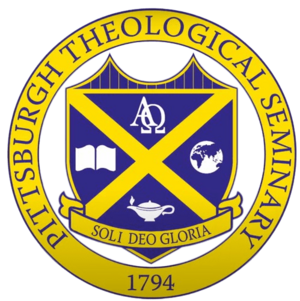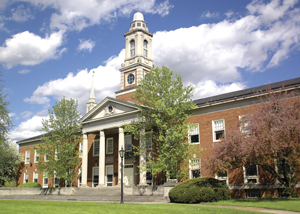Pittsburgh Theological Seminary facts for kids
 |
|
| Motto |
Soli Deo Gloria
|
|---|---|
|
Motto in English
|
Glory to God Alone |
| Type | Seminary |
| Established | 1794 |
| Accreditation | Association of Theological Schools in the United States and Canada and the Middle States Commission on Higher Education |
|
Religious affiliation
|
Presbyterian Church (USA) |
| President | Asa J. Lee |
| Students | 240 |
| Location |
,
,
United States
40°28′00″N 79°55′18″W / 40.46667°N 79.92167°W |
| Campus | Urban |
| Colors | Purple and Old Gold |
Pittsburgh Theological Seminary, often called PTS, is a special graduate school in Pittsburgh, Pennsylvania. It's a seminary, which means it trains people to become ministers in the Presbyterian Church. This school started a long time ago, in 1794. Today, PTS has one of the biggest libraries for religious studies in the Pittsburgh area.
Contents
A Look at PTS History
Pittsburgh Theological Seminary was created in 1959. This happened when two older schools joined together. They were Western Theological Seminary and Pittsburgh-Xenia Theological Seminary. This merger was part of a bigger event. In 1958, two large Presbyterian churches decided to become one.
How Pittsburgh-Xenia Seminary Started
The story of Pittsburgh-Xenia Theological Seminary began even earlier. It started with Service Seminary in 1792. This school was in a town called Service, in Pennsylvania. Before this, ministers for the church often came from Scotland.
The first teacher at Service Seminary was John Anderson. He started with just six students. Service Seminary moved several times over the years. It went from Service to Canonsburg, Pennsylvania, and then to Xenia, Ohio. In Ohio, it became Xenia Theological Seminary. This move happened in the 1850s. The school wanted to be closer to more people in the Midwest.
Later, in 1930, Xenia Seminary joined with another school. This other school was founded in Pittsburgh in 1825. It was known as Pittsburgh Seminary and later Allegheny Seminary. Together, they formed the Pittsburgh-Xenia Theological Seminary.
The Story of Western Theological Seminary
The other part of PTS's history comes from Western Theological Seminary. This school began with small academies in Washington, Pennsylvania. These academies were started in the late 1700s.
In 1825, the Presbyterian Church created Western Seminary. At that time, it was truly a "western" school. It helped train ministers for the new frontier areas along the Ohio River.
Since 1959, Pittsburgh Theological Seminary has been in the Highland Park/East Liberty area of Pittsburgh. It is on the campus that used to belong to Pittsburgh-Xenia Seminary.
What Students Learn at PTS
Pittsburgh Theological Seminary is officially approved by important groups. These include the Association of Theological Schools in the United States and Canada and the Middle States Commission on Higher Education. This means the school meets high standards for education.
Students at PTS can study many different areas of religious thought. They can also learn ancient languages like Greek and Hebrew. The seminary offers several types of degrees:
- Master of Divinity (M.Div.)
- Master of Arts in Pastoral Studies (M.A.P.S.)
- Master of Theological Studies (MTS)
- Doctor of Ministry (D.Min.)
The Doctor of Ministry program has special focus areas. These include Science and Theology, and Missional Leadership.
PTS also works with other schools in Pittsburgh. This allows students to earn two degrees at once. For example, you could earn a Master of Divinity and a law degree (Juris Doctor) from Duquesne University. Or, you could get a Master of Divinity and a social work degree (Master of Social Work) from the University of Pittsburgh.
The Clifford E. Barbour Library
The Clifford E. Barbour Library is a very important library for religious studies in Western Pennsylvania. It has over 300,000 books! It also has many online resources and more than 800 different magazines and journals. This makes it one of the largest stand-alone religious libraries in the United States.
The library building has three floors and was opened in 1964. It holds many valuable collections. One special collection is the John M. Mason Memorial Collection. It has many rare religious books from the time of the Reformation.
In one of the reading rooms, you can see the desk and chair of Karl Barth. He was a very famous theologian. His son, Markus Barth, was a professor at PTS from 1963 to 1972. A lot of the books in the library were bought with a large gift from a wealthy businessman named Thomas Clinton.
Kelso Museum of Near Eastern Archaeology
Pittsburgh Theological Seminary is also home to the Kelso Museum of Near Eastern Archaeology. This museum has a collection of ancient pottery and artifacts. These items come from the Near East and Palestine. They have been collected by travelers and archaeologists over many years. Many of the things on display were found during excavations that the seminary helped with.
Digging Up History at Tel Zayit
The seminary is very involved in Biblical archaeology. They help support the Zeitah Excavations in Israel at a place called Tel Zayit. This excavation started in 1999. It was led by Professor Ron E. Tappy, who teaches Bible and Archaeology at PTS. A team of experts and volunteers from around the world worked on the dig.
In July 2005, the excavators made an amazing discovery. They found the Zayit Stone. This was a 33-pound limestone rock with writing on it. The writing was from the 10th century BCE, which was around the time of King Solomon. This two-line inscription is the oldest clear example of the complete Hebrew alphabet ever found. The letters show how the Hebrew alphabet was developing from an older writing style. This discovery was so important that it was even reported in the New York Times.
World Mission Initiative
The World Mission Initiative (WMI) at Pittsburgh Theological Seminary is a group for Presbyterians.
WMI helps prepare students to become pastors. It also organizes trips to different cultures around the world. The goal is to train pastors who can serve the church globally. WMI often invites missionaries, church leaders from other countries, and scholars to visit the campus.
Notable People from PTS
Many important people have been part of Pittsburgh Theological Seminary.
Famous Faculty Members
Here are some well-known teachers who have worked at the seminary:
- Dale Allison
- M. Craig Barnes
- Robert A. J. Gagnon
- John Gerstner
- Archibald Alexander Hodge
- William Swan Plumer
- Andrew Purves
- Marjorie Hewitt Suchocki
- Benjamin Breckinridge Warfield
- Robert Dick Wilson
Notable Alumni
These are some famous people who studied at the seminary:
- Thomas K. Chadwick
- John A. Dalles
- Festo Kivengere, a Ugandan bishop and evangelist. He was known for speaking out against Idi Amin.
- Charles William Kerr, the first permanent Protestant Christian minister in Tulsa, Oklahoma.
- Isaac C. Ketler, who founded Grove City College.
- Calvin Wilson Mateer, who led the team that translated the Bible into Chinese.
- Robert H. Meneilly
- Fred Rogers, the beloved host of "Mister Rogers' Neighborhood."
- R. C. Sproul
- Lee Anna Starr (She was the first woman to graduate from Allegheny Theological Seminary in 1893).
- Neil M. Stevenson
- Ralph Watkins


